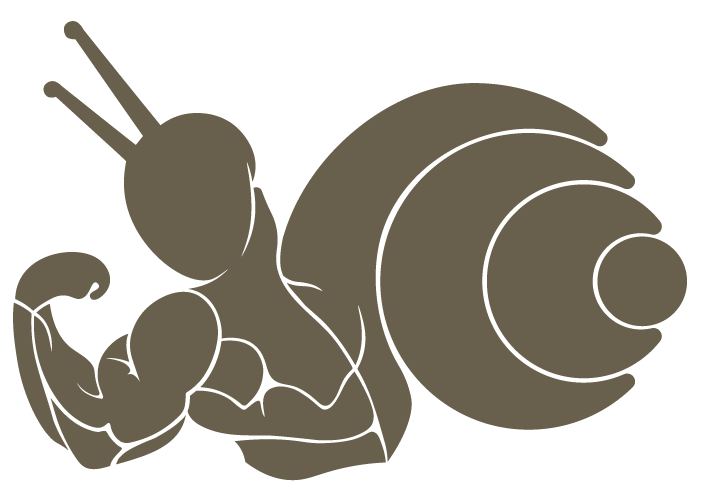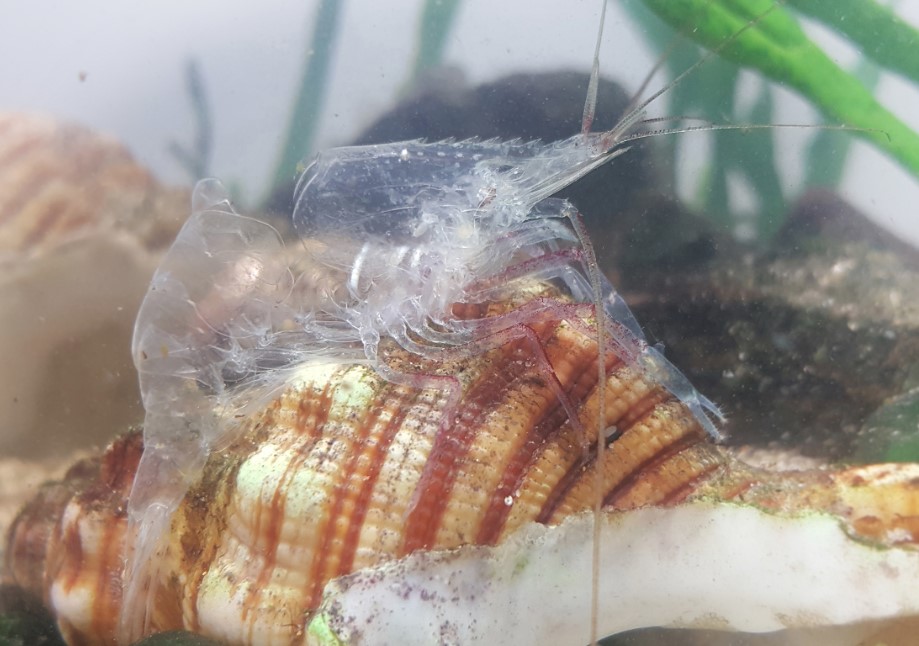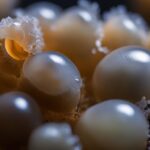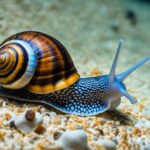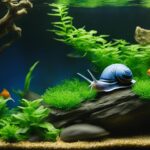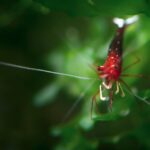Molting is an important process for shrimp to go through in order to survive and grow. Without molting, a shrimp’s exoskeleton would be too small to fit its growing body, making it impossible for the shrimp to progress into adulthood. As a result, molting is essentially the shedding of their outer layer that once served as an armor-like protection against predators and environmental elements. The molted exoskeleton typically crackles into several pieces along the dorsal portion of the body and is then removed by the shrimp.
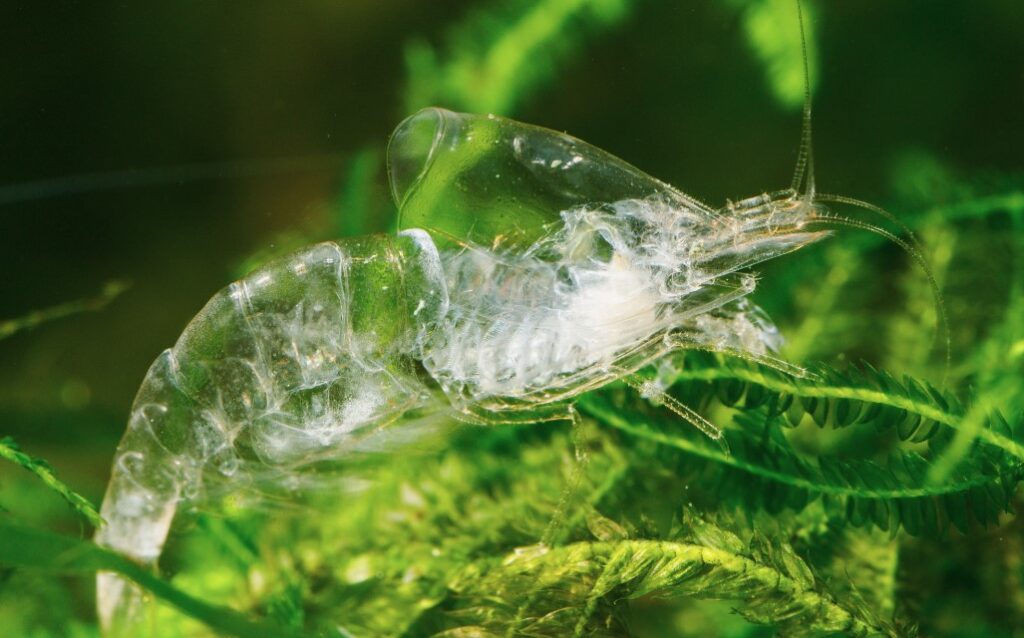
Once they’ve shed their shell, they absorb some water so they can grow larger for their next shell size up. It is very important that water parameters are kept consistent during this time; allowing them to rest assured in healthy conditions until their new exoskeleton fills out completely and hardens. Generally speaking, adult shrimp will molt every 3 or 4 weeks whereas younger shrimp tend to molt more often because of how quickly they are growing – sometimes as often as every week or two! Having an understanding of this process is essential in order for any shrimp keeper to ensure that their pet gets the best care possible.
Different Stages of Molting
Stage 1
The pre-molting stage of a shrimp’s life cycle is an important one, as these creatures work to prepare themselves for the next molt. During this period, a new hypodermis develops underneath the old exoskeleton, and this new layer of skin absorbs particles and chemical components from the old shell. As a result, the new exoskeleton gains hardness faster once the molting process is complete.
It is also interesting to note that during this time frame, shrimp will start eating less and less as they get closer to their next molting episode. On top of that, around 21-25 percent of their total body calcium gets absorbed from the old shell as well supplementing other necessary minerals. When all these changes are happening simultaneously, it does become visually obvious because the new shell can be identified with a naked eye when inspected properly.
Stage 2
The molting process for shrimp is a fascinating one that involves the breaking of the old exoskeleton at the neck area. During this process, the shrimp will slowly fill its body with water until it reaches a predetermined point known as the breaking point which can then be released in fractions of a second. A burried female may experience this same process, although it is quite rare. Allowing the eggs to be saved from a dead shrimp is possible through an artificial hatching method, but they will not survive unless you take intervention.
After successfully molting and hatching offspring, all aquatic crustaceans must go through what is known as ‘softshell’ phase where the newly formed exoskeleton must harden before taking full form. To ensure that this stage does not leave them vulnerable to predators, shrimp hide amongst debris until their new shell solidifies. This entire molting process demonstrates a truly remarkable adaptation of these creatures and why they are important to aquatic ecosystems as part of their biological cycle.
Stage 3
The post-molting stage begins once the molting process is complete and can last from 12 to 36 hours for an adult shrimp. It is the shortest stage in a shrimp’s development, whose main purpose is for the shrimp to rest and recuperate from the process of molting. During this time, the shrimp needs to absorb a substantial amount of water in order to be able to stretch its body out and inflate its new shell with water so it can fully develop.
To ensure that this happens as quickly and smoothly as possible, it is important that during the post-molting stage, the levels of oxygen in their habitat remain high enough for successful respiration. Additionally, there should be a sufficient number of food sources available to provide them with additional energy since they will certainly be more active after molting.
As with any other animal creature, proper care needs to be taken during all stages of their lives. For shrimps going through this particular stage, it is essential that they have access to a safe environment with plentiful food resources as well as plenty of clean water for them able properly continue their growth cycle. If all these conditions are met then they should no difficulty finishing up this transitional period and emerging into their new shell.
Stage 4
The inter-molting stage is an important part in the life cycle of a shrimp. This is the period where the body and exoskeleton function without any major restrictions, allowing the shrimp to grow quickly and efficiently. During this stage, they are able to eat as much as they can in order to gain weight, an essential element to prepare for upcoming molting cycles.
With each molt cycle comes greater growth potential, so during this inter-molting stage, shrimps are preparing their bodies for what lies ahead. Without proper nourishment during this period, a shrimp’s development will be hampered and even halted completely – leading to adverse health effects. Therefore it’s important that suitable nutrition is provided in order to ensure optimal development throughout a shrimps lifetime.
Understanding Molting
Molting is a natural behavior in shrimp, though it can be disconcerting to observe as a hobbyist. Before molting, the shrimp will usually stand still for an extended period of time. They may not move more than their antennae and many won’t even feed while in this mode. This should cause no concern unless there are an extremely high number of shrimps who appear to be pre-molting at the same time – in which case it could indicate a problem with water quality that needs immediate attention.
In most cases, if you leave them alone the shrimp will successfully molt in just a few hours and all will be well again. After they molt, the exoskeleton is soft and vulnerable so they’ll hide away from predators until it hardens – usually taking about two days. Once their shell rehardens, your shrimp should return to their usual activities free from worry of being eaten by a predatory fish or invertebrate.
What is Exoskeleton
Exoskeleton is the external covering of some living organisms, such as arthropods. It is usually composed of three main components: chitin, proteins, and calcium carbonate. Chitin is an organic compound made up of polysaccharides of amino sugar, making it a tough yet flexible material. Proteins are complex molecules that give structure to cells and tissues as well as having functions of their own. Calcium carbonate is also known as calcite, which is a mineral that lends stiffness to the exoskeleton. Additional elements may also be included in exoskeletons depending on the species it serves.
Comparatively with other animal structures, an exoskeleton offers many advantages for its wearer; primarily protection from different threats such as collision or predation but also serves as a way to diminish water loss and absorb food particles through tiny pores present in the shells. Additionally, by using these structures animals can gain mechanical power enabling them to move faster and more efficiently while better retaining heat during colder temperatures. For instance, certain spiders use an exoskeleton to build webs strong enough to resist raindrops twice their size by programming “structural plasticity” into their silk proteins when they produce the webs.
In conclusion, exoskeletons are essential for the survival of many organisms and provide them with a variety of benefits such as protection, efficient movement and thermoregulation. Understanding how these structures work can help us better understand the biology behind invertebrates and their evolutionary history.
Shrimp Eating Molt
When the shrimp has outgrown its old exoskeleton, it will cast off this shell and grow a new one in its place. Interestingly, shrimp actually enjoy eating their old molt as it provides them with an added daily dose of calcium which helps build up their new exoskeleton even stronger than the last one.
This also means that you can go ahead and leave the shed exoskeletons in the tank instead of scooping them up and out for cleaning. Just make sure that there aren’t too many lying around – otherwise they can cause oxygen deprivation by blocking too much light from filtering through or overcrowding and causing water stagnation.
Water Condition and Shrimp Molting
Maintaining proper water parameters is of the utmost importance when keeping shrimp, as insufficient or unsuitable conditions can lead to poor molting. Poor molts can affect your colony’s growth and even lead to premature deaths due to decreased immunity or an inability to complete a molt cycle. You need to focus on two main parameters – General Hardness (GH) and Carbonate Hardness (KH). These two factors help establish optimal calcium and carbonate levels in the tank water that help shrimp build better exoskeletons during moulting.
The Total Dissolved Solids (TDS) level is also important for maintaining good quality water parameters, although it doesn’t provide detailed chemistry information like GH and KH measurements. It is recommended that adequate TDS levels be kept in your colony’s tank on a regular basis so as not to interfere with moulting processes and other biological functions of shrimp. In addition, if sudden deaths appear after performing water changes, checking this parameter can help solve the problem quickly.
